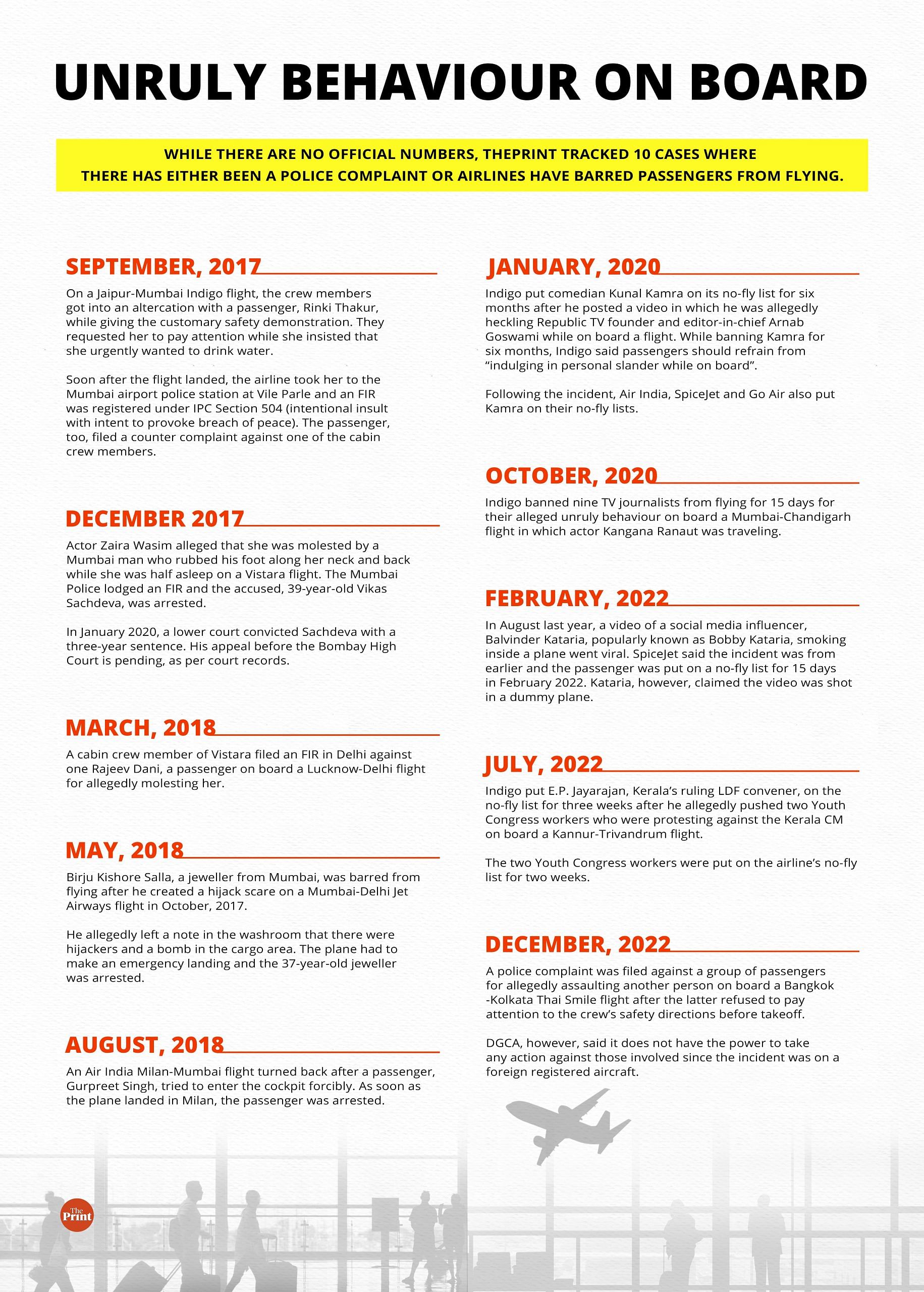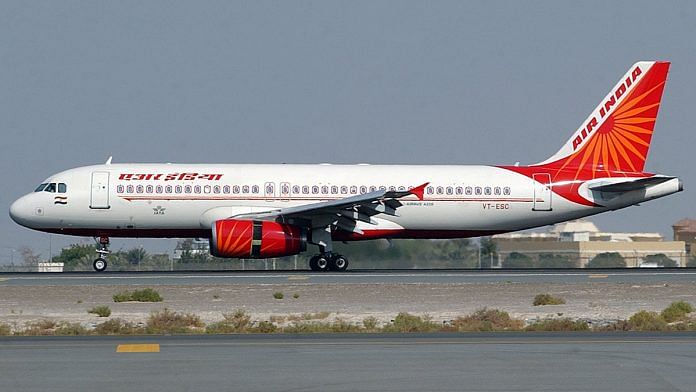Mumbai: The case of Shankar Mishra who urinated on a fellow passenger on board an Air India flight has put the spotlight on India’s regulations to deal with unruly or disruptive air passengers and the practical challenges that crew members and pilots face in implementing these guidelines.
Airlines are often afraid of potential bad press that may come along with acting against unruly passengers, while crew members and pilots are wary of the consequences and counter complaints that passengers may file against them, senior and retired pilots and cabin crew members told ThePrint.
As a result, it has been nearly six years since the Directorate General of Civil Aviation (DGCA) released guidelines on dealing with unruly passengers. In that time, there have been only a handful of cases of airlines putting supposedly disruptive passengers on their ‘no fly list’ for a certain duration or registering police complaints against them.
The DGCA officially does not share data of the number of incidents involving “unruly” passengers reported to it by individual airlines. Arun Kumar, director general, DGCA, told ThePrint, “We do not share this data due to privacy issues.”
However, anecdotally, retired cabin crew members and pilots peg the total number of such cases to be not more than 15-20 since the DGCA published its guidelines in May 2017.
“In almost every flight, there are one or two flyers who will misbehave. The levels may vary. Most of them don’t get reported because either the crew comes to an understanding with the passenger after an apology, or the captain may be called who may warn the passenger about consequences,” a senior pilot who did not wish to be named told ThePrint.
“Airlines don’t want too many cases of difficult passengers to be publicly known because it is possible that some may interpret it as the quality of service being offered in an airline that is leading to more tussles between the passengers and the crew. So, reporting a passenger and putting him or her on a no-fly list is usually an extreme action,” he added.
Also read: Urinating in cup to physical harassment, cabin crew say many mid-air altercations go unreported
DGCA’s guidelines
The DGCA published its guidelines for the “handling of unruly or disruptive passengers” two months after then Shiv Sena MP Ravindra Gaikwad had an altercation with an Air India staffer during which the MP allegedly abused as well physically assaulted him.
Air India as well as other airlines barred him from flying. But, as there were no official ‘no fly’ guidelines, the Union government was compelled to study the legality of the airlines’ decision and come up with a set of rules.
“Although unruly passengers represent only a minute proportion of passengers as a whole, we must never forget that one aggressive passenger can jeopardise safety on board. Unruly passengers affect all personnel involved in the process connected with a flight operation,” the DGCA’s guidelines say.
According to the guidelines, all airlines need to have a manual for how to deal with unruly passengers, clarifying the role of the ground staff, crew members, airline airport manager, airline central operation control and so on.
The guidelines say, unruly behaviour of passengers could be the result of “unsatisfactory service/condition or effect of a series of such events that build up”. Crew members need to identify early signs and deal with such passengers rather than allow situations to escalate. What constitutes an offence needs to be clearly displayed to the passenger at prominent locations in the airport terminal building.
The DGCA guidelines categorise what makes for “unruly behaviour” in three levels. Level 1 refers to disruptive behaviour by physical gestures, verbal harassment and unruly inebriation, in which case the airline can bar the passenger from flying for up to three months.
Level 2 includes cases of physically-abusive behaviour such as pushing, kicking, hitting, inappropriate touching and so on, in which case the concerned passenger can be put on the no-fly list for up to six months.
Level 3 applies for life-threatening behaviour such as murderous attempts, damage to the aircraft’s operating systems and so on. In case of a Level 3 offence, the airline can bar a passenger from flying for a minimum period of two years or more without limit.
The airline needs to communicate its ‘no fly list’ to the DGCA.
Every airline needs to have an internal committee for probing incidents of allegedly unruly behaviour. The committee comprises a retired district and sessions judge, a representative of another airline and a representative from a passengers’ or a consumers’ association. The committee decides which level the offence falls in and if the passenger needs to be barred from flying.
‘Pilots often in Catch 22 situation’
As per the guidelines, the pilot-in-command has to quickly assess if the cabin crew can control the “unruly” passenger and accordingly relay this information to the airline’s central control.
“The guidelines put a lot of responsibility on the pilot-in-command and often the pilot finds himself in a Catch 22 situation,” a retired pilot with over five decades of flying experience told ThePrint.
“Reporting an incident often gets pilots flak about why they didn’t try to resolve it at their end, because reporting an incident also means press attention, so pilots often wonder if they can sort it out at their end,” he said.
Nidhi Chaphekar, a former senior Jet Airways cabin crew member who became the face of the 2016 Brussels terror attack, told ThePrint that crew members usually try to handle disruptive behaviour with a four-step approach.
“First, you do a soft approach. If that doesn’t work then there is verbal judo with the passenger. You have to play with your words. Then there is an authoritative stern approach and warning of consequences. The last step is that you take action. But for all of this it is very important to have witness of other passengers,” she said.
The senior-most cabin crew first tries to handle the situation, after which it escalates to the captain, but it is important for the captain to be kept informed of every such incident, she said.
Police complaints in such cases are few because the procedure is lengthy, involving five to six hours where the security of the airline, passenger, concerned crew members and, if possible, witnesses, all are required to be present, Chaphekar said. “You don’t know what the passenger’s background is, and it can draw bad press for the airline,” she said, adding that young cabin crew members are especially cautious about taking action out of fear that it might boomerang.
Another senior steward, who wished to not be named, said airlines fear that passengers can file a counter complaint slamming the airlines’ services. “They can say they weren’t served food, cabin crew misbehaved, the AC wasn’t working properly,” he said.
“So, most of the time, these instances are suppressed or the crew members reach some sort of an understanding with the passenger,” he added.

(Edited by Zinnia Ray Chaudhuri)
Also read: ‘Unruly’ behaviour on NY-Delhi flight one-off incident? Not exactly, but FIRs filed negligible



